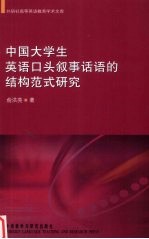图书介绍
中国大学生英语口头叙事话语的结构范式研究PDF|Epub|txt|kindle电子书版本网盘下载

- 俞洪亮著 著
- 出版社: 北京:外语教学与研究出版社
- ISBN:7560054064
- 出版时间:2006
- 标注页数:288页
- 文件大小:13MB
- 文件页数:301页
- 主题词:英语-语言学-研究-英文
PDF下载
下载说明
中国大学生英语口头叙事话语的结构范式研究PDF格式电子书版下载
下载的文件为RAR压缩包。需要使用解压软件进行解压得到PDF格式图书。建议使用BT下载工具Free Download Manager进行下载,简称FDM(免费,没有广告,支持多平台)。本站资源全部打包为BT种子。所以需要使用专业的BT下载软件进行下载。如BitComet qBittorrent uTorrent等BT下载工具。迅雷目前由于本站不是热门资源。不推荐使用!后期资源热门了。安装了迅雷也可以迅雷进行下载!
(文件页数 要大于 标注页数,上中下等多册电子书除外)
注意:本站所有压缩包均有解压码: 点击下载压缩包解压工具
图书目录
INTRODUCTION1
1 Overview2
2 Need for the study2
3 Significance of the study8
4 Outline of the book10
5 Summary11
PART Ⅰ LITERATURE REVIEW12
Chapter One Narrative Theories and Studies13
1.1 Overview13
1.2 The conceptual definition of narrative13
1.3 Narrative structure17
1.4 Some related empirical narrative studies19
1.5 Summary46
Chapter Two Research Methods In Narrative Studies47
2.1 Overview47
2.2 Qualitative methods employed in the previous narrative studies47
2.3 The employment of three qualitative methods50
2.4 Justifying the employment of the qualitative approach to narrative54
2.5 Qualitative data analysis framework for this study55
2.6 Summary59
PART Ⅱ METHoDoLoGY61
Chapter Three A Qualitative Design62
3.1 Overview62
3.2 Research questions62
3.3 Material63
3.4 Data analysis65
3.5 Narrative components in the data analysis framework73
3.6 Summary79
Part Ⅲ RESULTS AND DISCUSSIoN80
Chapter Four Describing the Macrostructure of L2 Learners'Oral Narratives81
4.1 Overview81
4.2 The macrostructure of L2 learners'oral narratives81
4.3 Micro-analysis of two sample cases:An illustration82
4.4 Summary88
Chapter Five Generating the Narrative Structure of Character-centric Monologues89
5.1 Overview89
5.2 The narrative map generated from the character-centric monologues89
5.3 The structural representations of the macro-categories90
5.4 Summary117
Chapter Six Generating the Narrative Structure of Event-centric Monologues119
6.1 Overview119
6.2 The narrative map generated from the event-centric monologues119
6.3 The structural representations of the macro-categories120
6.4 Summary133
Chapter Seven Comparing the Narrative Structures Across Different Topics135
7.1 Overview135
7.2 Comparing the macrostructures between different topic groups135
7.3 Comparing the microstructures between different topic groups136
7.4 Describing a merged narrative structure ofthe learners'monologues149
7.5 Developing a conceptual model of the learners'oral narratives151
7.6 Summary161
Chapter Eight Comparing the Narrative Structures Across Different Levels of Oral Proficiency162
8.1 Overyiew162
8.2 Cross-level comparisons of the macrostructures162
8.3 Cross-level comparisons of the microstructures163
8.4 Summary196
CONCLUSION197
1 Overview198
2 Major findings198
3 Theoretical implications200
4 Practical implications207
5 Limitations of the study211
6 Directions for future research213
7 Summary213
REFERENCES215
APPENDIXES244
Appendix Ⅰ Transcripts of“Unusual Teacher”Sample Cases(TEM-4 Oral English Test 2001)244
Appendix Ⅱ Transcripts of“Birthday Party”Sample Cases(TEM-4 Oral English Test 2000)266
Appendix Ⅲ Rewrite Rules in Mandler and Johnson's Story Grammar Model287
Chapter One22
Table 1.1:The Subordinate Elements in an Episode22
Table 1.2:Story Grammar Categories(Stein & Glenn 1979)24
Table 1.3:The Labovian Model of Narrative Structure(Labov 1972)27
Table 1.4:The Relation of Evaluation to the Other Elements in the Labovian Model30
Table 1.5:The Structural Features Shared by the Four Models42
Chapter Three64
Table 3.1:Information About Task 2 in Oral TEM-Band 4(2000 and 2001)64
Table 3.2:Brief Data Information About the Selected Cases65
Chapter Four82
Table 4.1:Frequencies of Each Macro-category in the Sampled Cases82
Chapter Seven135
Table 7.1:Frequency Distribution of EV Across Different Topics135
Table 7.2:Frequency Distribution of ID Types Across Different Topics136
Table 7.3:Frequency Distribution of TC Across Different Topics140
Table 7.4:Frequency Distribution of IL Types Across Different Topics144
Table 7.5:Frequency Distribution of IR Across Different Topics146
Table 7.6:Distribution of EV Types Across Different Topics148
Chapter Eight162
Table 8.1:Frequency Distribution of Each Macro-category Across Different Levels162
Table 8.2:Frequency Distribution of ID Types Across Different Levels164
Table 8.3:Frequency Distribution of IC Across Different Levels in Different Topic Groups165
Table 8.4:Frequency Distribution of TC Types Across High-and Low-level UT Groups167
Table 8.5:Frequency Distribution of IL Types Across High-and Low-UT Groups173
Table 8.6:Frequency Distribution of IL Types Across High-and Low-level BP Groups181
Table 8.7:Frequency Distribution of IR Across Different Levels186
Table 8.8:Proportion of IR Segments in the Core Narrative of Example 8.15189
Table 8.9:Frequency Distribution of EV Types Across Different Levels193
Table 8.10:Frequencies of Two Minor Types of Absent EV Across Different Levels195
Chapter Four81
Figure 4.1:The Macrostructure of the Chinese EFL Learners'Oral Narratives81
Chapter Five90
Figure 5.1:The Narrative Map Generated from Analysis ofthe UT Cases90
Figure 5.2:The Two Variations of ID Internal Structure in the UT Cases91
Figure 5.3:The Three Variations of IL Internal Structure in the UT Cases98
Figure 5.4:The Graphic Representation of Low-UT Case 10103
Figure 5.5:The Three Strucural Realizations of EV in the UT Cases112
Chapter Six120
Figure 6.1:The Narrative Map Generated from Analysis of the BP Cases120
Figure 6.2:The Internal Structure of ID in the BP Cases121
Figure 6.3:The Episode of Temporal Events in Event Frame in the BP Cases126
Figure 6.4:Four Types of Event Sequences in Episode-oriented IL of the BP Cases129
Chapter Seven150
Figure 7.1:The Merged Model of Narrative Structure Generated from both UT and BP Narrative Maps150
Figure 7.2:The Conceptual Model of L2 Learners'Oral Narratives152
CONCLUSION209
Figure 9.1:The Suggested Components of Discourse Competence in Communicative Language Production209